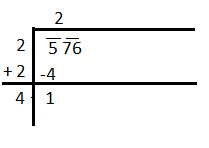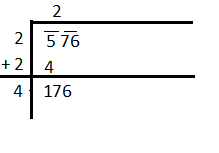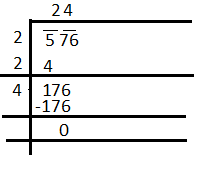
Find the square root of 576 by division method
a) 36
b) 24
c) 34
d) 46
Answer
523.5k+ views
Hint: Follow the rule of division method for finding the square root of any number. Put bars from the unit place and use two digits for one bar. Now think of the largest number whose square is even to just less than the first bar digit in the number. Now subtract and bring down the quotient to the divisor, now add a new digit in quotient and divisor (in front) and repeat it to get the quotient. At last when remainder becomes o, quotient is the square root of it.
Complete step-by-step solution -
Division method for finding square root can be given as
(a) First place a bar over every pair of digits starting from unit digit, if the number of digits are odd then the left most single digit will also have a bar.
(b) Think of the largest number whose square is even to first less than the first bar digit. Take this number as divisor and also as quotient.
(c) Next subtract the product of the divisor and the quotient from the first bar digit and bring down the next pair of digits which have a bar to the right side of the remainder, that becomes a new dividend.
(d) Now, the new divisor is obtained by adding the first divisor and the quotient and add a digit to the right side of it that we have to choose according to the new dividend which is chosen in such a way that product of new divisor and this digit is less than or equal to the new dividend.
(e) Repeat steps (b, c, d) till the bar digit has been taken up. Now quotient is the required square root of the given number.
Let us put bars to the given number from starting to the last digit in pairs as per the rule of division method.
So, we get number 576 as
Hence, we can divide 5 by 2 as

Now, put 76 to the adjacent 1. So, we get

Now, put a digit adjacent to 4 and same digit in the quotient as well (adjacent to 2) such that multiplication of number in the divisor and quotient (digit) will be less than or equal to 176. So, we get
Hence, put 4 to the adjacent 4 and divide 176 by 44. So, we get

Hence, square root of 576 is the quotient in the above method i.e. 24.
So, option (b) is the correct answer.
Note: Don’t put bars from the starting of a number in the division method. It is a general mistake done by students with this method. Always put the same digit in divisor and quotient. They should be the same for getting the square root. Bars should be only on maximum two digits and minimum on one digit.
One can verify the square root by calculating it by prime factorization method.
Complete step-by-step solution -
Division method for finding square root can be given as
(a) First place a bar over every pair of digits starting from unit digit, if the number of digits are odd then the left most single digit will also have a bar.
(b) Think of the largest number whose square is even to first less than the first bar digit. Take this number as divisor and also as quotient.
(c) Next subtract the product of the divisor and the quotient from the first bar digit and bring down the next pair of digits which have a bar to the right side of the remainder, that becomes a new dividend.
(d) Now, the new divisor is obtained by adding the first divisor and the quotient and add a digit to the right side of it that we have to choose according to the new dividend which is chosen in such a way that product of new divisor and this digit is less than or equal to the new dividend.
(e) Repeat steps (b, c, d) till the bar digit has been taken up. Now quotient is the required square root of the given number.
Let us put bars to the given number from starting to the last digit in pairs as per the rule of division method.
So, we get number 576 as
Hence, we can divide 5 by 2 as

Now, put 76 to the adjacent 1. So, we get

Now, put a digit adjacent to 4 and same digit in the quotient as well (adjacent to 2) such that multiplication of number in the divisor and quotient (digit) will be less than or equal to 176. So, we get
Hence, put 4 to the adjacent 4 and divide 176 by 44. So, we get

Hence, square root of 576 is the quotient in the above method i.e. 24.
So, option (b) is the correct answer.
Note: Don’t put bars from the starting of a number in the division method. It is a general mistake done by students with this method. Always put the same digit in divisor and quotient. They should be the same for getting the square root. Bars should be only on maximum two digits and minimum on one digit.
One can verify the square root by calculating it by prime factorization method.
Latest Vedantu courses for you
Grade 8 | CBSE | SCHOOL | English
Vedantu 8 CBSE Pro Course - (2025-26)
School Full course for CBSE students
₹45,300 per year
Recently Updated Pages
Master Class 10 General Knowledge: Engaging Questions & Answers for Success

Master Class 10 Computer Science: Engaging Questions & Answers for Success

Master Class 10 Science: Engaging Questions & Answers for Success

Master Class 10 Social Science: Engaging Questions & Answers for Success

Master Class 10 Maths: Engaging Questions & Answers for Success

Master Class 10 English: Engaging Questions & Answers for Success

Trending doubts
A boat goes 24 km upstream and 28 km downstream in class 10 maths CBSE

Why is there a time difference of about 5 hours between class 10 social science CBSE

The British separated Burma Myanmar from India in 1935 class 10 social science CBSE

The Equation xxx + 2 is Satisfied when x is Equal to Class 10 Maths

Chandigarh is the capital of A Punjab B Haryana C Punjab class 10 social science CBSE

What are the public facilities provided by the government? Also explain each facility




